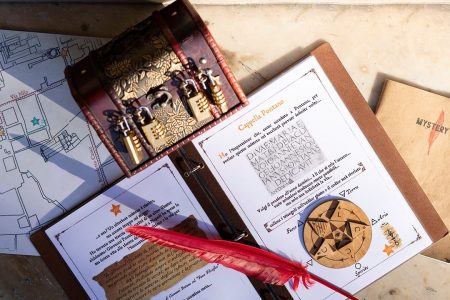Table of Contents
October 31 is just around the corner, and with it comes the most terrifying holiday of the year! Halloween is a typically American custom, but in recent years it has become a fun custom in Italy as well. In fact, more and more often we see children dressed up as monsters running around asking for candy to the cry of "Trick or Treat."
Its origins are Celtic, and as a symbol par excellence we have the famous carved and illuminated gourd, known as the Jack-O'-Lantern. In our country, there is no shortage of Halloween-themed evenings for adults who look forward to the fun of ghoulish locations, monsters and lurking spirits.
The city of Naples itself is no exception, and on Halloween day there is no shortage of parties, ghost tours, esoteric experiences and what not. It may be the proximity to the feast of the dead, but in the Neapolitan capital, Celtic rituals blend wonderfully with Neapolitan ones.
The origins of Halloween
The word Halloween would appear to date back to 1745 and is of Christian origin. In fact, it is supposed to derive from the English expression All Hallows' Eve, or All Saints' Eve. The earliest records of its celebration date back to the early Middle Ages in northern European countries such as Ireland and England.
This ancient rite would thus be linked to All Saints' Day and the Feast of the Martyrs, which Pope Gregory III allegedly moved to November 1. In the 19th century, however, some scholars speculated that the Halloween tradition was inspired by Samhain, an archaic Celtic holiday that celebrated the end of summer. The expression meant "summer's end," and it was a ritual designed to banish fear of the coming of winter by giving thanks to the deities.
Death was the recurring theme of the festival, and it was believed that on October 31 the spirits of the dead could return to earth to reunite with the world of the living. In fact, Samhain fell at the turn of two seasons, and on such a day the veil dividing the two worlds became thinner.
You might be interested
The Secret of the Immortals: private treasure hunt through the alleys of Naples
per person Book
In fact, several members of our clergy do not approve of this carnival in horror sauce because of its pagan roots and still represents a very controversial issue today. Over time Halloween has become a primarily commercial and consumerist custom, and from the United States it has invaded many other countries, including Italy.
Trick-or-treating in Naples
As we know, Halloween is a purely Anglo-Saxon celebration, and many think it is a tradition typical only of those countries, but the ritual of masked boys and children running around asking for candy is also rooted in Neapolitan culture.
In fact, the writer herself Matilde Serao in 1904 told us about the habit of Neapolitan children walking around with a small cardboard or tin box with a slit on it during the time of the Feast of the Dead. The box was called 'O tavutiello because it resembled a small coffin and on it they drew a skull and two crossbones.
Kids scampered around town in groups singing a nursery rhyme: "Signurì 'e muorte/ sott 'â péttola che nce puorte/ e nce puorte 'e cunfettiélle/ signurì 'e murticiélle!" Then there are testimonies that instead tell of another version of the chant: "Do me well, pe' li muorte: dint'a 'sta péttula che 'ce puórte? Passe e ficusecche 'nce puórte e famme bene, pe' li muorte."
In other parts of the province of Naples and the rest of Campania, local children preferred to shout "dead fats". Chicharrones were nothing more than grains of wheat that were boiled and then steeped in sugar and honey to make up a poor but very good dessert.
Even in the past, October 31 was therefore a special day, during which tables were left set and laid to give comfort to the souls of deceased loved ones who were returning to this world. Some people would set the table with an extra place or leave the table ready after dinner.
Even, some families would leave buckets full of water under the window to give these souls coffins. In addition, between Halloween and November 2, there was widespread production of the so-called "nougat of the dead" chocolate and hazelnut bricks that are called morticians because they are shaped like a coffin. The custom of exchanging sweets would be a way to exorcise the fear of death and alleviate the sadness of these days.
If you are in the mood to experience the spirit of Halloween in beautiful Naples, you can take advantage of some fun experiences that will make this date nothing short of unforgettable!
For example, why not participate in this fascinating witch tour in the historic center of Naples or to this evocative Lantern Festival at Lake Fusaro To experience the magic of Halloween in a spooky forest! What are you waiting for? Come spend the scariest night of all with us!


0 Comments